|
Paper 22
Nathaniel Gow (1763-1831)
& John Gow (1764-1826), Band Leaders & Publishers
Contributed by Paul Cooper, Research Editor
[Published - 18th March 2016, Last Changed - 29th August 2024]
The Edinburgh based Nathaniel Gow was arguably Britain's most successful band leader of the Regency era, his fame was comparable to that of James Paine of Almack's Assembly Rooms, the subject of a previous research paper. He remains of significant interest today for his many contributions to Scottish music history. In this paper we'll discuss the influence of Nathaniel and his brother John, we'll also comment on their role in the transfer of dance culture between London and Edinburgh during the 1810s and 1820s.
Life of Nathaniel Gow
This paper will only offer a brief biography of Nathaniel Gow as an excellent 19th century biography already exists. If you'd like to discover more about his life then I recommend reading his entry in the 1835 A Biographical Dictionary of Eminent Scotsmen.
Nathaniel Gow was the 4th son of the celebrated Niel Gow. Niel was a travelling musician and a composer of tunes, he became famous throughout Scotland and many of his tunes are still used for dancing at Ceilidhs today. He died in 1807, it was Nathaniel who posthumously published much of his father's work. A brief reference in the Morning Post (27th March, 1804) described Neil (variant spellings were not unusual) Gow as the father of the Scotch music , which is indicative of the esteem in which he was held in London at the time. The Examiner in 1840 called him Famous Neil . Niel Gow's collections of Reels, Strathspeys and Country Dances are appreciated today as being amongst the most important archives of traditional Scottish folk music. Niel Gow's services to Scottish music are sometimes likened to Robert Burns' services to Scottish songs; they were both part of a reinvention of national identity at this period, celebrating traditional (the word nostalgic also comes to mind) Scottish arts.
Nathaniel took after his father, he too is remembered today as both a violinist and composer. In 1796 he opened a music shop in Edinburgh, it survived for around 17 years before closing in 1813 after the death of his business partner. He started a second music publishing venture in 1819, this time in partnership with his son Niel (sometimes referred to as Neal ); Niel died in 1823 (The Scots Magazine, 1st December, 1823), the business went bankrupt in 1827 (Newcastle Courant 19th May, 1827). His main success was as a band leader, in the words of the Biographical Dictionary of Eminent Scotsmen:
It is difficult to describe the influence, success, and reputation of Nathaniel Gow, during all the time he conducted the fashionable bands in Edinburgh and throughout Scotland; but certain it is, that in these respects he stands at the head of all that ever trode in the same department. Not only did he preside the peers' balls, Caledonian Hunt balls, and at the parties of all the noble and fashionable of Edinburgh, but at most of the great meetings and parties that took place throughout Scotland; and in several instances he was summoned to England. No expense deterred individuals or public bodies from availing of his services; and it appears from his memorandum books, that parties frequently paid him from one hundred to one hundred and fifty guineas, for attending at Perth, Dumfries, Inverness &c with his band.
Nathaniel is reported to have travelled to London and to have played at several fashionable balls there. In so doing he caught the attention of the Prince Regent: on his visits to London [he] had the honour of being invited to play at the private parties of his Majesty, when Prince of Wales, at Carlton House . A few years later in 1822, the Regent, now King George IV, visited Scotland. The King singled out Nathaniel and publicly praised him, further enhancing his reputation. This was the height of Nathaniel's success.
Nathaniel married twice. His first wife was Janet Fraser with whom he had five daughters and one son. She died in early 1809. He then engaged himself to Mary Hogg only to call off the engagement; he lost £700 in 1812 in a legal settlement for breach of promise of marriage (Kentish Gazette, 14th August, 1812, see also The Scots Magazine). He subsequently married Mary in 1814, they had a further four children together.
In later life Nathaniel suffered financial complications and lost much of his wealth, he was bankrupt in 1827. He died in 1831 at the age of 67. He left behind him a treasury of publications and a great many tunes both of his own composition and adapted from others.
An obituary in The Morning Post (26th January 1831) reports:
On Wednesday last Nathaniel Gow, the well known Scottish violinist, and composer of numerous popular national airs, expired at his house in Edinburgh, after a painful illness of several years. In his latter days Mr. Gow had enjoyed a pension from King George IV, who, it will be recollected, treated him with some marks of Royal condescension, on observing him at the head of his band in Dalkeith House, in 1822 .
One of his most loved tunes was (according to Grove) Caller Herring, which was advertised as New Scotch Music in London in the Morning Post for 27th May 1802. It was adapted many times and lyrics were subsequently written to accompany it; one such adaptation was that of Joseph Hart, who arranged the tune for use as a Quadrille in his 1827 8th Set of Scotch Quadrilles, another is in an c.1808 Country Dance published by Wheatstone.
John Gow and the Gow Bands
The Gow brothers were celebrated as being amongst the greatest musicians of their generation. Barclay Dun in his 1818 A Translation of Nine of the Most Fashionable Quadrilles commented on the Scottish Strathspey: There is certainly something irresistibly whimsical and pleasing in the accent of the Strathspey. We are indebted for this mirth-inspiring expression to the late celebrated Neil Gow, whose sons, the one at present in London, and the other in Edinburgh, excel in the performance of this species of music. .
Gow's band was a household name amongst the London elite of Regency Britain. The Morning Post regularly reported on fashionable society, including the balls of the nobility; for several years it was common for Gow's band to be mentioned in their reports. But, somewhat confusingly, there were at least two Gow bands, both known by that same name. Scottish references to Gow's Band usually refer to the Edinburgh based band of Nathaniel Gow, London references usually refer to the band of John Gow, Nathaniel's younger brother. John Gow (also known as Jock , 1764-1826), had a similar career to that of Nathaniel; he also ran a music shop, the address of which varied over time but was always in London. He was less celebrated and is better remembered today for his musical publications than as a band leader; he died in 1826 (Glasgow Herald, 1st December 1826). There were two further Gow brothers (a third having died in infancy), William Gow (1751-1791) and Andrew Gow (1760-1803), both were recognised to be excellent violinists. According to the 1906 Grove's Dictionary of Music and Musicians, Andrew Gow was a partner with John in the London based music business, until his death in 1803; William led the orchestra at the Edinburgh Assembly Rooms until 1791 (Nathaniel took over after William's death).

Figure 3. A Celebrated Performer in the Philharmonic Society, 1818 © Trustees of the British Museum
It's rare for contemporary references to Gow's Band to be specific about which Gow led the band, this confuses the historical record. We know that Nathaniel visited London on several occasions (such as the 1835 reference to his having played at Carlton House), he was the more famous of the surviving Gow brothers, it's likely that some of the English references refer either to Nathaniel or to a combination of both Nathaniel and John. I've generally assumed that English references are to John unless the context clearly implies otherwise. For example, an 1807 description of The Contess of Powis's Ball in London reported that Mr Gow, and Mr Nathaniel Gow, from Edinburgh, were present , this clearly demonstrates that generic references to Mr Gow might not have implied Nathaniel (Morning Post, 19th June 1807); their father had already died by this date, the Mr Gow referred to was presumably John.
A reference in the 1834 Chambers's Edinburgh Journal confirms that John Gow was the principal leader of the London band. In a report on the death of their father, the Journal said that He left behind him two sons and a daughter: John, who settled in London as leader of the fashionable Scottish bands, and who died in 1827, after acquiring a large fortune; Nathaniel; and Margaret . John regularly played for the Highland Society in London, and also at fund-raising events for the Caledonian Asylum in London, they awarded him a medal in 1822 inscribed: Presented to Mr. John Gow, in testimony of their approbation of his long services, and of the delight which his eminent and hereditary musical talents have never failed to inspire (The Morning Post, 15th May 1822). A letter collected in the 1873 Archibald Constable and His Literary Correspondents: A Memorial dated 21st March 1807 reports on a dinner hosted by the Highland Society in London:
We had an excellent piper; and John Gow and his band to play Scotch tunes to us. John Gow plays extremely well, which is more than can be said of the rest of his band, which consisted of four other violins, violoncello, harp (French pedal), and French horn, - a curious variety compared with our NATHAN of Edinburgh. They are very very far behind indeed, as may well be supposed.
A description of one of Nathaniel's Balls from 1814 survives (Caldedonian Mercury, 22nd January 1814) at which the effect was greatly heightened by the additional accompaniment of the French horns, flute, flageolet, bassoon, and hautboy. The band was excellent, and was conducted by Mr Gow, with his usual ability. . The musical arrangement for the Gow bands could clearly vary from one event to another.
It's quite likely that when Nathaniel travelled south he would have performed with his Brother's musicians (even though they were a poor substitute for his band in Edinburgh!). A first-hand account of Nathaniel Gow's own band can be found in John Melish's 1818 Travels Through the United States of America. It records the following anecdote from Edinburgh in 1809:
... after which we had the song of "Scots wha hae wi' Wallace bled," followed by the air to which Burns originally composed it, by the inimitable band of Nathaniel Gow; and so mournfully pathetic did they play it, that it brought a plentiful shower of tears from the eyes of many of the company.
Every toast was followed by music, and never did I hear music more elegant or better arranged. Nathaniel Gow, a son of the celebrated Niel Gow, led the band, and to use the language of my Liverpool friend, he "handled his elbow in great style;" and was well supported by the other performers.
Nathaniel Gow held an annual ball at the Assembly Rooms at George Street in Edinburgh. Adverts for this ball exist from at least 1800 when it was promised that Niel Gow himself would be present (Caledonian Mercury, 3rd March 1800). The Morning Post for 27th March 1804 (see Figure 4) included a report of one of Nathaniel's Annual Balls:
Mr. Nathaniel Gow, son of Mr. Niel Gow, the father of the Scotch music, had his Annual Ball here about a fortnight since. It was given at the Assembly Rooms in George-street, under the pattronage of: Her Grace the Duchess of Buccleuch, the Right Hon. the Countess of Dalhousie, Lady Charlotte Campbell, Lady Montgomerie, Lady Dalrymple Hamilton, the Hon. Mr. Dundas of Arniston, &c. &c..
The ball-room is one of the largest in the United Kingdom. About ten o'clock the company began to assemble, and before twelve, eleven hundred persons had paid admission. Among the company were, the Commander in Chief, Earl Moira and suite, Lady Charlotte Rawdon, Mr. and Mrs. D. Scott, the Duchess of Gordon, &c. &c. An elegent supper took place at one o'clock; about two the ball re-commenced and was kept up with that degree of spirit peculiar to the country, until six o'clock, when the company retired.
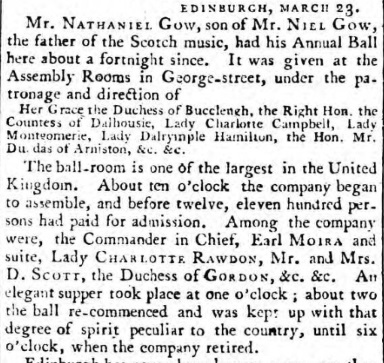
Figure 4. The Morning Post, 27th March 1804. Image © THE BRITISH LIBRARY BOARD. ALL RIGHTS RESERVED. Image reproduced with kind permission of The British Newspaper Archive ( www.britishnewspaperarchive.co.uk)
In addition to hosting his own balls, Nathaniel's band provided the music at many other balls. For example, the Caledonian Mercury for 26th January 1805 carried adverts for two Edinburgh balls by Fortune & Son and F. Davison, each of which emphasised that the music would be provided by Gow. A report in the Caledonian Mercury for 9th March 1809 hints that Gow's own Annual Balls were becoming almost too popular: Mr. Gow was honoured with the presence of all the beauty and fashion in and for many miles round the metropolis, last Tuesday, at his Annual Ball. He had prepared a few new dances for the occasion, which were played in the course of the evening, but not one of them could be danced for want of room. The band was excellent, and performed a number of beautiful slow airs, which were very much admired. Adverts for Nathaniel's Annual Balls can be found in the Caledonian Mercury for almost every year from 1800 to 1823. From around 1812 Nathaniel Gow began promising new music at each ball to be published shortly after the event (Caledonian Mercury, 29th February 1812), usually through Robert Purdie's music shop. Nathaniel's final advertisement for an Annual Ball appears to have been in 1823 (Caledonian Mercury, 3rd March 1823), making for at least 24 Annual Balls in total, all at the George Street Rooms.
One particularly unusual and comment-worthy ball was reported in The Scot's Magazine (1st August 1817). It described a Grand Naval Entertainment given on board a ship at Leith: Gow's band and the ship's band played alternately; and the band of the 6th dragoon guards was stationed on the beach when the company came off .
Meanwhile, John Gow and the London based band were similarly occupied. A passing reference in 1802 (Morning Post, 3rd February 1802) mentions that a dancing master called Mr Allen had hired a Gow (probably John, but potentially Andrew): Mr Gow and Mr Mackintosh are engaged ... to lead the Band alternately, that those who are found of good Music may enjoy the pleasure of dancing to a Band conducted by two of the best Performers of Ball Music in this country . An account in The Morning Post for 27th July 1805 reported on a coming of age ball for Mr. Vyse at Stoke Park, Buckinghamshire. It reports:
The company invited, exceeding 170 personages of distinction, being arrived, the ball commenced at half past nine o'clock, with the favourite dance, La Belle Laitiere, by Mr. Vyse and the Countess of Woronzow. About 15 couple followed. In the second dance two sets were formed. It was not until half past two that the company retired from the ball room to supper, having danced without a moment's intermission for five hours - a circumstance almost unexampled in the history of the fashionable world at this season of the year. To the animating music of Mr. Gow's Band we can only ascribe the prolongation.
A similar coming of age party for the young Mr. Farquharson was described in the Salisbury and Winchester Journal for 21st October 1805; it reported: ... Gow's band, consisting of three violins, a violoncello, harp, and tambourine, performed several pieces of national music with equisite effect . Numerous other performances of Gow's Band are recorded: Mr Penn's Divertisement (The Morning Post, 27th June 1806); assorted masquerades at The Pantheon (e.g. The Morning Chronicle, 29th April 1807); Hampstead Subscription Rooms (The Morning Post, 26th October 1807); a Ball at High Wycombe (Morning Post, 8th October 1808, see Figure 5);
Mrs. Chichester's Masquerade (The Morning Post, 12th June 1809); Mr. Pendock Barry Neale's Ball (The Morning Post, 6th June 1810); the Scottish Hospital balls (e.g. The Morning Chronicle, 2nd December 1811); he superintended the two bands of music at Lady Mary Lindsay Crawfurd's Ball (The Morning Post, 15th July 1813); assorted Masquerades at the Argyll Rooms (e.g. The Morning Post, 18th February 1814); the Scottish Corporation's entertainments (e.g. The Morning Post, 8th May 1815); the Master of the Ceremonies Ball at Margate (The Morning Post, 2nd October 1817); Ramsgate (The Morning Post, 11th October 1817); Gow gave universal satisfaction at a ball at Berkhamstead (The Morning Chronicle, 27th October 1817); Dr. Gray's Villa (The Morning Post, 6th October 1818); the Grand Caledonian Balls at Almack's (e.g. The Morning Post, 15th May 1822); the Caledonian Fete at Vauxhall (The Morning Post, 7th July 1825); and finally at Lady Clarendon's Ball (The Morning Post, 31st March 1826).
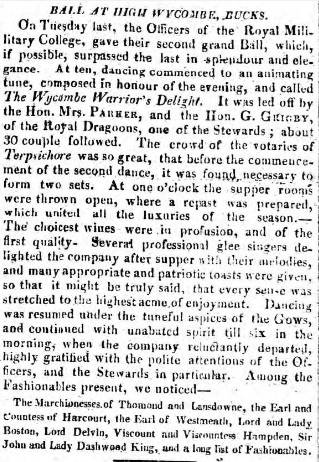
Figure 5. The Morning Post, 8th October 1808. Image © THE BRITISH LIBRARY BOARD. ALL RIGHTS RESERVED. Image reproduced with kind permission of The British Newspaper Archive ( www.britishnewspaperarchive.co.uk)
On several occasions we know that John Gow's Band played alongside other bands. For example, a report in The Morning Post described a Ball at Wanstead House (9th August 1816) at which Gow's band was accompanied by James Paine's band: At one o'clock the dancing commenced in the saloon, and the long room; in the first waltzes, in the last country dances. Mr Gow presided in the latter, Mr Paine in the former. A similar combination was reported at The Regent's Ball in 1819: One of the windows was taken out for the purpose of fitting up a temporary orchestra for the amusements of the evening, in which was stationed a very numerous and excellently selected Band of first-rate performers. The Quadrilles were called by Mr. Moyart, and led by Mr. Paine, of Almack's - the Country Dances, by Mr. Gow. Perhaps Nathaniel Gow himself was present for this Royal Ball. John Gow's band also played alongside Edward Payne's band at Mrs Beaumont's Ball (The Morning Post, 19th May 1814), and one of the great John Weipperts (two musical brothers shared that same name) is reported to have accompanied Gow's Band on the Harp at Margate in 1817 (The Morning Post, 11th October).
John Gow was also associated with Almack's Assembly Rooms.
Captain Gronow famously reported in his 1862 Reminiscences that Neil Gow (presumably John Gow, Gronow's memory failed him on numerous occasions) was a regular performer c.1814. The anonymous author of the 1863 Recollections of Almack's recalled the delicious sounds of Weippert's or Gow's band .
Gow's Band even appeared in fiction in Elizabeth Helme's 1814 novel Modern Times; or, The Age We Live In. A fictional and whimsical assembly was planned, and: ...nothing now remained but to carry these great designs into execution, and for Mr. Frolic to engage the performers for this grand scene, such as Gow's band, the flageolists, peacocks, macaws, cockatoos, parrots, paroquets and other vocal and instrumental actors,... . A similar reference can be found in the anonymously published 1825 Husband Hunting; or, The Mother and Daughters: Neil Gow's band, that ubiquitarian troop, whose harps and fiddles seem to meet us at all corners of the isle at once, was in full harmony,... (the author may have been unaware that there was more than one Gow Band, and that Niel had died nearly two decades earlier).
The bands of Nathaniel and John Gow were routinely referred to simply as Gow's Band , their presence at a ball indicated that the hostess could afford the very best. We've written of John Bowie (1759-1815), another musician who played alongside Nathaniel Gow, elsewhere, you might like to follow the link to read more.
The Gows and Mr George Jenkins of London
In 1820 Mary Gow, the third daughter of Nathaniel, married George Jenkins (Evening Mail, 24th July 1820). Jenkins was perhaps the most influential teacher of dancing in London at this time, having taught Princess Charlotte and probably other members of the Royal family to dance (Morning Post, 27th August 1801), and much of the Nobility (Dublin Evening Packet and Correspondent, 3rd April 1834). Biographical details of the Jenkins family are scarce, but they're sometimes credited with coining the term Highland Fling (a claim over which I have doubts, see below).
Mr Jenkins Senior, also named George, was a London based dancing master sometimes employed by the Duchess of Gordon. It's highly probable that he was Scottish; his children may have been born in Scotland too, but the younger George spent most of his life in England. A report of the 1792 Duchess of Gordon's Ball in The Kentish Gazette, 8th May 1792, mentions: the two young Jenkins's, habited in the garb of their country, were called on for a Scots dance, which they executed with universal applause; this was followed ... with a much admired Scots measure by the elder Jenkins . Mr Jenkins senior died in 1798 (Oxford Journal, 17th March 1798), but the Duchess continued to favour the son. The Caledonian Mercury for the 16th February 1799 reported on another Duchess of Gordon's Ball at which Mr Jenkins, by the direction of the Duchess, superintended the dancing . Both events featured Scottish music, dancing and entertainments. An 1807 biography of the Duchess of Gordon mentions the introduction of Scotch dancing into the fashionable world, which art the Messrs Jenkins, father and son, have brought to its present perfection .
At some point one of the Jenkins began publishing music. Their major publication was a collection of Scottish dance music called New Scotch Music, consisting of Slow Airs, Strathspeys, Quick Reels, Country Dances, and a Medley on a New Plan (see Figure 6). It was published by a George Jenkins, Teacher of Scottish Dancing, I suspect the elder Jenkins. This work was published in 1797 (based on a review in the April 1797 edition of the Monthly Magazine in which it's described as New Music ) and is noteworthy for including an early reference to the Highland Fling, this explains why the dance is sometimes credited to them. Several earlier references to the Highland Fling are available however; one of the earliest I know of being in the Caledonian Mercury for the 1st May 1790, in which it's promised that a stage production of All in the Wrong at the Theatre Royal in Edinburgh will be followed by A Highland Fling by Duncan McTavish . Given that the term pre-dates the Jenkins' publication I think it's unlikely that they coined it. An even earlier reference to the Fling links it with the young Prince George, later George IV; the Morning Post for 18th January 1786 reported: The Caledonian Reel still continues to be the fashionable country dance in all assemblies which the Prince honours with his presence; he calls it the Bonny Duchess, in honour of her Grace of G-----, who first gave him an idea of the Royal Highland Fling, which he now performs with all the activity and spirit of a Strathspey-man . Perhaps the Duchess of Gordon and the future King invented the Royal Highland Fling themselves, and teachers such as Mr Jenkins promoted the dance in honour of the Prince?
Jenkins was credited by several other dancing masters as being influential. For example, the Edinburgh based Mr Ritchie travelled to London in 1802, his advert on his return reported (Caledonian Mercury, 9th October 1802) Mr R. begs to add, that he has been favoured by Mr JENKINS, Teacher to the Royal Family, with a great variety of new Steps for Scotch Reels and Country Dances now danced at Court . Dance mistress Signora Rosignoli, also in Edinburgh, advertised in 1805 (Caledonian Mercury, 15th June 1805) that she is returned to this City, from London, after improving herself by the celebrated Mr Jenkins, Teacher of Dancing to her Royal Highness the Princess of Wales . There's a certain irony in a major Scottish Dancing Master like Ritchie travelling to London to learn new steps for Scottish dances, from a London based dancing master; it hints that nationalistic dancing conventions were less clearly established two hundred years ago than is sometimes imagined.
Following his marriage into the Gow family there was a collaboration with John H. Gow, the son of John. In 1821 John H. published his Second Set of Quadrilles with entirely new Figures, by Mr. G. Jenkins (Morning Chronicle, 30th January 1821). Jenkins had previously supplied figures for L.F. Dainville's 1817 Le Brocage Quadrilles, and in 1822 he went on to publish his own La Fantaisie Quadrilles (Morning Post, 18th April 1822). Further references to George Jenkins' academy in London can be found in the 1820s. Jenkins was also, almost certainly, the author of an important 1822 book published in London called The Art of Dancing.
Mr Jenkins senior, the father of Nathaniel's son-in-law, could genuinely be responsible for the term Highland Fling . Nathaniel Gow, in his 1820s third edition of Part Second of the Complete Repository of Original Scots Tunes, indicated that the tune called The Marquis of Huntlys Highland Fling was by the late Mr George Jenkins , presumably implying that it was written by Mr George Jenkins Senior. The tune may have pre-dated its 1797 publication, so the Jenkonian claim remains plausible. I can offer an alternative theory however. An advert printed in The Chester Courant, 19th January 1796, printed by a dancing master named Mr Cotgrave indicates that he had been taught the the original highland fling steps by Mr Wills. Alexander Wills was one of the highest profile of London's dancing masters of the 1790s, and another Scotsman, it's plausible that he was the originator of the Highland Fling. Wills worked alongside other influential dancing masters including Mr Second and Mr Charriere, and he had both studied under and partnered with the great Giovanni Sir John Gallini (perhaps the most important dance practitioner of late 18th Century London). Wills employed a Mrs Gow as his director of music, quite possibly John's wife (Morning Post, 16th February 1801). He briefly employed Jenkins Senior to teach the newly fashionable Scottish style of dancing in London (The Times, 25th December 1789), before going on to specialise in teaching the Scottish style himself (The Times, 15th June 1792); he even planned a tour of Scotland in order to master the Scottish techniques. He could have brought the Highland Fling back from Scotland with him (c.1793), or have invented it himself (prior to 1790), or have learnt it from George Jenkins Senior (c.1789) before teaching it to Mr Cotgrave. Although it's possible that the Highland Fling was invented in London by Jenkins or Wills (perhaps in friendly imitation of Prince George's enthusiastic reel stepping), I prefer to think it an indigenous Scottish invention. Somewhat curiously, Alexander Wills and George Jenkins Junior were both credited as being reputed the best dancing masters in London according to an 1800 Italian phrase dictionary. Alexander Wills was also associated with popularising the Irish style of dancing in London, one of the best sources of information for which is his 1800 Ten Fashionable Irish Dances.
The Will of George Jenkins senior is available to read at the National Archives. It reveals that George Jenkins junior was the youngest of his four surviving children.
The Gow's Influence on British Dancing
Any attempt to summarise the state of Scottish dancing during the Regency era is as difficult as doing the same thing for English dancing of the same period. Both traditions had a great deal in common. Scotland's dancing masters regularly travelled to the great metropolis of London to refresh their knowledge of fashionable styles; some went further and travelled to Bath, Paris, and elsewhere.
Examples of influential dancing masters bringing London's fashionable dancing to Scotland include Mr Dun (probably Barclay Dun) who advertised that he has arrived from London (Perthshire Courier, 4th October 1810), Barclay went on to be amongst the first to teach the Waltz in Edinburgh (Caledonian Mercury, 19th October 1811); Alexander Strathy (Perthshire Courier, 1st October 1812) who was just returned from London, where he has acquired a variety of beautiful Spanish, German, and French Dances , he went on to teach Quadrille dancing (Perthshire Courier, 13th October 1814); John Lowe (Perthshire Courier, 19th September 1816) claimed to have lately been in London and Edinburgh and he has acquired the most fashionable style ; Mr Ritchie advertised that (Caledonian Mercury, 9th October 1802) he is now returned from Paris and London, where he has been these some months in the way of his profession, studying under the most approved Masters ; Mr Bayne (Aberdeen Journal, 22nd June 1808) had studied under the first Masters in London and Edinburgh, for some years past ; Mr Cameron (Aberdeen Journal, 10th October 1810) taught new Dances through his visits to London each season ; Mr Macindoe (Glasgow Herald, 26th September 1828) had studied under the most eminent Masters of Paris, London and Edinburgh ; Mr Laurie had frequently been in London and Paris, to receive instructions in his Profession from the first Masters (Caledonian Mercury, 23rd October 1802); Robert Lowe writing from Bath (Glasgow Herald, 25th September 1820) reported: In place of again visiting Paris as he intended, Mr L. is now on a Tour to some of the most celebrated places of fashionable resort in England, which he hopes will prove of great advantage to his pupils . Even veteran dancing masters such as Francis Peacock had the advantage of a regular tuition under the best Masters in London according to his 1807 obituary (Aberdeen Journal, 8th July 1807), and David Strange had studied dancing under the celebrated Signor Gallini at London and also under the two first Masters in France (Caledonian Mercury, 1st December 1764). Many further such examples can be found.
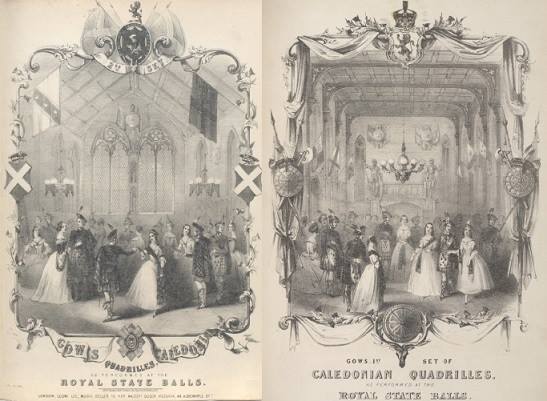
Figure 7. Imagery from Victorian editions of Gow's Quadrilles
Image © BRITISH LIBRARY BOARD, h.931.(41.) ALL RIGHTS RESERVED
Broadly speaking, two important traditions existed in Scottish social dancing of the early 19th Century: the traditional dances of the highlands (the term traditional is problematic, but includes such dances as the Reel and Strathspey), and the ballroom dances popular in the London Assembly Rooms (they're often described as French , but their distinguishing characteristic is that they were fashionable in London, and therefore throughout Britain). The Gow brothers encompassed both traditions. The first tradition is exemplified in the collected works of Niel Gow (as edited by Nathaniel Gow), the second can be seen in the Quadrille dances from London, including those published in Edinburgh by Nathaniel Gow. John Gow's band was the most popular Scottish band in London; Nathaniel's Annual Assemblies were an important conduit for bringing London's fashionable dances to Edinburgh.
Nathaniel and John had arranged to share material between the two cities; John published Nathaniel's best Works in London, and Nathaniel did the same for John in Edinburgh. Nathaniel's 1824 advert in the Caledonian Mercury (14th February, announcing his continuation in business following the loss of his son Niel), also mentioned the alliance with John: N.G. begs leave to intimate that he has just received ... all the new and fashionable music, selected as usual by Messrs John Gow and Son of London. From the connection of the two houses, the public may depend on having every Article in the line of the best quality. He expanded further in an advert in the Edinburgh Advertiser (28th May 1824): From the irreparable loss Nathaniel Gow has sustained in the death of his Son, who was to have visited London twice in the year, to select music and instruments for carrying on the business in all its branches, that task has been kindly and voluntarily undertaken by his brother and nephew in London, Music Sellers to his Majesty, No 162, Regent Street: and from his nephew, John H. Gow, being constantly on the spot, (and who is a most excellent judge of every article connected with the trade,) the friends of Nathaniel Gow may depend upon having every thing new almost as soon as it appears in London. This liberal conduct of his brother and nephew determined him at once to continue the business, as he can do so with satisfaction to his friends. . John Gow made similar statements in his adverts, such as the 1823 advert (The British Press, 9th July 1823) in which he claimed to be a Music and Musical Instrument seller, (by special appointment), to his Majesty , it goes on to mention the availability of all the works published by Nath. Gow and Son, Music-sellers to his Majesty, Edinburgh . The Gow's were each other's agents and publicists.
John H. Gow (John's Son) printed an advert in 1817 (The Morning Post, 1st July) advertising the availability of his own First Set of Quadrilles with the Figures in French and English, collected in Paris, and dedicated with permission... , the implication is that he personally travelled to Paris to gather these Quadrilles, though it was hardly necessary to do so. He published several further Sets of Quadrilles, including his 5th Set in 1822 (The Morning Post, 30th May). As with Joseph Hart, he arranged his Quadrilles to be consistent with the First Set, but provided alternative figures for dancers who preferred variety. The London based Gow band was advertised to be playing Quadrilles, Waltzes, &c. in 1817 (The Morning Post, 9th May 1817), it probably played John H. Gow's Quadrilles.
Nathaniel Gow published several sets of French Quadrilles from 1817. Three Sets were published through Robert Purdie as performed by Mr Gow and his Band, at his Annual Ball in George Street Rooms, The 11th March 1817, with their proper figures as danced at Mr Smart's Academy . These French Quadrilles went on to be known as Gow's Scotch Quadrilles , they may have been the first Quadrilles published in Scotland. The term French is problematic at this date, it's as likely to imply the style referred to in London as French as literally French . The French style of figure dances had been popular in Britain since at least the 1770s, they were well established by the 1810s, even if a new wave of French social dancing was spreading throughout the Country. This general terminological confusion is even more clear with the phrase Parisian Quadrilles which came to mean those Quadrilles danced at Almack's Assembly Rooms in London . Many British dancing masters claimed to have travelled to Paris to learn fashionable dancing techniques in the early 19th Century; I suspect that some of them only travelled as far as London (or even just bought a book published in London!). Disambiguating references is difficult; Nathaniel didn't claim to have travelled to Paris and I've no reason to think that he did so. Nathaniel's Quadrilles were French in the sense that all Quadrilles were French; in most cases they were British productions in what was referred to as a French style, with standard arrangements of figures printed in French.
A further series of publications emerged around this time, also published by Purdie, under the title A New Selection of Quadrilles, Waltzes, & Spanish Dances, as performed by Mr. Gow and his Band; at least eight such sets were published, the first contained a variety of dances (including a Spanish Country Dance, a variation of the Country Dance introduced in London around 1815) but the rest were Sets of Quadrilles. I've not managed to date this second series precisely, though the first three were published no later than 1818. They're of interest as the covers of most of these works claim that they're taught by Messrs Dun, Smart, Ritchie & Strathy . These gentlemen were amongst the foremost dancing masters in Edinburgh at the time, it seems that they were all promoting Nathaniel Gow's Quadrilles. Two sets of these Quadrilles became so popular that they went on to be known as the Second and Third Sets of Quadrilles, and were promoted as such across Edinburgh and Scotland (the First Set were of course the Set from London of the same name).
Note: Having commented on the problematic provenance of the Gow Quadrilles, I've since found a Quadrille Set published in Brussels by Hendrik Messemaeckers which appears to include variants of some of Gow's music. This curious publication is called Choix Des Plus Jolies Contredanses Exécutées dans les differentes fêtes données a Bruxelles par S. A. R. le Prince d'Orange et par S. A. Le Duc de Wellington Prince de Waterloo, figures par Mr Sacré Professeur de Danse. This work is tentatively dated to 1816, so it could be one of Gow's sources. There again, it may be a later publication printed using music that was already circulating in Britain!
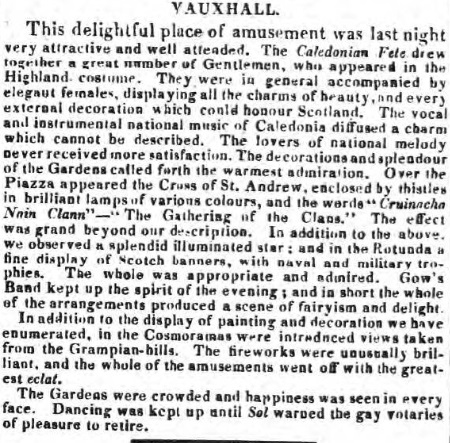
Figure 8. The Gow band plays at Vauxhall Gardens, The Morning Post, 7th July 1825. Image © THE BRITISH LIBRARY BOARD. ALL RIGHTS RESERVED. Image reproduced with kind permission of The British Newspaper Archive ( www.britishnewspaperarchive.co.uk)
The firm of Dun and Son are of particular importance in the growth of the Quadrille in Scotland. Elizabeth Grant in her Memoirs of a Highland Lady recorded the introduction of Quadrilles to fashionable society in Edinburgh:
...we young people were all bit by the Quadrille mania; and I was one of the set that brought them first into notice. We practised privately by the aid of a very much better master than Mr. Smart. Finlay Dunn had been abroad, and imported all the most graceful steps from Paris; and having kept our secret well, we burst upon the world...
Grant went on to describe how her new Quadrilles were danced at many select dinner parties during the 1816/1817 season. Grant doesn't mention Gow, but Finlay Dun was the son of Barclay Dun, and co-owner of Dun & Son, they're closely associated with Nathaniel Gow. Barclay Dun published his A Translation of Nine of the Most Fashionable Quadrilles in 1818, it contained a collection of the most popular Quadrilles selected from the works of Edward Payne (of London) and Nathaniel Gow. Dun mentioned the Gows several times in his publications. Grant, however, was mistaken if she believed that she had introduced Quadrilles to Scotland; Alexander Strathy had been teaching them since at least 1814 (Perthshire Courier, 13th October 1814), and Mr Laurie taught them in 1805 (Caledonian Mercury, 5th December 1805) (though the degree of similarity between an 1805 Quadrille and an 1817 Quadrille is open to debate).
Several commentators thought it amusing that Quadrilles should be danced in Scotland. The 1819 Peter's Letter to His Kinsfolk discusses Scottish dancing in general, and Quadrille dancing in particular. It's a satirical work, so shouldn't be taken too seriously, but the opinions expressed were unfavourable: What big, lazy, clumsy fellows one sees lumbering cautiously, on toes that should not be called light and fantastic, but rather heavy and syllogistic. The letter discusses several aspects of contemporary Scottish dancing that are interesting, but without relating directly to the Gows (except in so far as they acknowledge the increasingly French influence in Scotland). London's Morning Chronicle newspaper for the 5th March 1821 carried the story of a kilted Quadrille Ball that was held in Edinburgh: We understand that, bating the indelicacy of the thing, the Ball went off very well, the dresses of several of the Chieftains being very splendid, and that no dirks were drawn, and no Lady either fainted or screamed. One thing we cannot withhold from out readers: the company danced quadrilles, and we really must say, that nothing conveys to us a more ludicrous idea than kilted Gentlemen figuring in the insipid monotony of a French Quadrille .
A European influence from London may have been taken North to Scotland, partially through the music and publications of Nathaniel Gow, but a Scotch influence was also brought South to England, partially through the music and publications of John Gow. The most popular Scottish Dance of the period was the Scotch Reel, and it had been enjoyed in England for several decades. Thomas Wilson published several new Reels in London, John Gow's band would have provided the ideal accompaniment for such dancing. A particularly famous Reel was danced at The Duchess of Richmond's Ball in Brussels immediately prior to the 1815 Battle of Waterloo; one of the Duchess' daughters recalled: I well remember the Gordon Highlanders dancing reels at the ball. My mother thought it would interest the foreigners to see them, which it did. I remember hearing that some of the poor men who danced in our house died at Waterloo. There was quite a crowd to look at the Scotch dancers. . Francis Peacock, a veteran dancing master from Aberdeen writing in 1805, commented on the popularity of the Scotch Reel in London at the start of the 19th Century; John Gow's band may have helped to fuel that demand.

Figure 9. The Caledonian Mercury, 22nd March 1821. Image © THE BRITISH LIBRARY BOARD. ALL RIGHTS RESERVED. Image reproduced with kind permission of The British Newspaper Archive ( www.britishnewspaperarchive.co.uk)
It must of course be acknowledged that the Scottish influence in London wasn't universally approved of. An interesting retrospective account was published in the Dublin Evening Packet and Correspondent (3rd April 1834, in turn quoting from the Court Journal of a slightly earlier date) that summarised many decades of British dancing. It praised the dancing of the mid 18th Century, then added: To this grand epoch of the art succeeded the fatal era of the Jenkinses, Niel Gow, and Scotch steps ... by the time the Princess Charlotte became of an age to appear in the mazy round, Jenkins had transformed the leading belles of the day into so many effigies of cork, bounding up and down without grace or measure . Ouch. The 20 year old Princess Charlotte was married in 1816, and died in labour in 1817, the period referred to is therefore solidly Regency. It might further be added that London's prevailing style of dancing Scottish dances wasn't necessarily the same as that of Edinburgh.
As a little aside, it's interesting to note that there was an important change in the character of London's fashionable Country Dancing from the 1790s - it became increasingly common for the galloping style of leading to be danced (galloping is a convention in which the active couple take both of their partners hands and slip down the middle of a longways set, usually as fast as they can). We've written about this convention before; it's possible that it was introduced at Court by George Jenkins. If so, the reference to bounding up and down without grace or measure takes on a potentially new significance.
A similar statement may be made about the European influence in Edinburgh. An opinion published in the Caledonian Mercury for 22nd March 1821 (see Figure 9) was quite blunt:
With what feelings of regret, if not indignation, does not every true son of Caledonia see our reels, our strathspeys, and country dances, almost banished from the fashionable public and private parties of the season, and in their room that comparatively insipid and to us utterly unintelligible dance, the quadrille, universally introduced? These wretched attempts, made by our metropolitan fashionables to rival their French neighbours in the grace, the gaiety, and true spirit of their dancing, are, in the mean time, truly deplorable; they excite only the smiles and the jokes of our foreign visitors, and we ourselves are obliged to acknowledge our ridiculous affectation in admiring and imitating every thing coming from abroad.
That writer went on to complain of having recently attended a public ball (probably one of Nathaniel Gow's) at which Scottish Reels had been used as the music for dancing the Lancers Quadrilles - a popular Set of Quadrilles created in Dublin in 1817.
The Gow brothers, and associates such as George Jenkins, Alexander Wills and Barclay Dun, were amongst the many agents of cultural transfer between London and Edinburgh during the early 19th Century. There were other musical firms with a presence in both London and Edinburgh, including those of Robert Bremner and Corri, Dusek & Co., they will also have played a role in synchronising musical and dance trends between the two cities. London's style of Assembly Room dancing became particularly popular in Edinburgh in the mid Regency and 1820s, that led to some of the most important works on British Quadrille dancing being published in Scotland. That list included: Dun's 1818 A Translation of Nine of the Most Fashionable Quadrilles; Strathy's 1822 Elements of the Art of Dancing; the 1822 Lowe's Ball Conductor and Assembly Guide; the anonymous 1823 The Etiquette of the Ball-Room; and a variety of Quadrille dances published by the likes of Gow, Richie, Murray, MacDonald and so forth. A tradition also emerged in London around 1821 of naming Quadrilles after Scotland, resulting in Hart's Scotch Quadrilles and Chivers' Caledonian Quadrilles amongst others; this trend may have been influenced by the many Scottish musical publications (including Nathaniel's own Quadrilles) that had been published in London by John Gow & Son.
Gow Publications
The Gows published many works, both through their own music shops and through others. The table below lists some of the more interesting from the perspective of Assembly Room dancing. There were many further musical publications not included in this list, but it does include most of the more significant works. Some of the works are available on the internet, if you own copies of works that are not currently available, do please consider having them scanned and sharing them.
| Work & Date | Image | Comments |
A Collection of Strathspey Reels, etc.
Niel Gow
1784 |
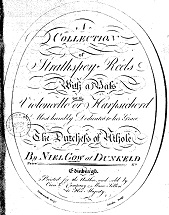
|
A second edition of this work carefully corrected and improved, with the addition of Twelve Tunes (not to be foud in the First Edition, nor in any other of his Works) was advertised in the Caledonian Mercury for 27th May 1802.
This collection of traditional Scottish tunes are available on-line through IMSLP. It contains the music for a collection of tunes, but no dancing figures are suggested for use.
Full Title: A Collection of Strathspey Reels, with a bass for the Violoncello or Harpsichord. Most humbly dedicated to her Grace The Dutchess of Athole. By Niel Gow of Dunkeld.
|
12 Favorite Country Dances, & 4 Cotilions
John Gow
1788 |
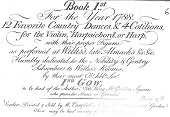
|
This is an early collection by John Gow printed in London. It's unlike most other Gow collections in that it includes Cotillion dances, and dancing figures for the Country Dances.
Full Title: Book 1st, for the year 1788. 12 Favorite Country Dances, & 4 Cotilions, for the Violin, Harpsichord, or Harp, with their proper figures, as performed at Willis's, late Almack's &c. &c. Humbly dedicated to the Nobility & Gentry Subscribers to Willis's Rooms, by their most obedient, humble servant, Ino Gow.
Image © BRITISH LIBRARY BOARD, b.55.b.(6.) ALL RIGHTS RESERVED
|
A Second Collection of Strathspey Reels, etc.
Niel Gow
c.1788 |
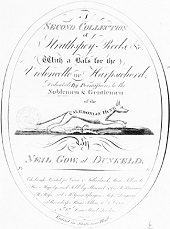
|
This collection of traditional Scottish tunes are also available through IMSLP. Note that the cover refers to Neil Gow rather than Niel Gow , variant spellings of his name are not uncommon.
Full Title: A Second Collection of Strathspey Reels &c. with a bass for the Violoncello or Harpsichord. Dedicated by permission to her Noblemen & Gentlemen of the Caledonian Hunt. By Neil Gow, at Dunkeld.
|
A Third Collection of Strathspey Reels, etc.
Niel Gow
1792 |
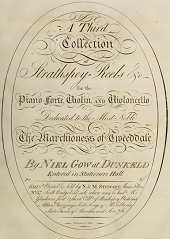
|
This collection was advertised in the Caledonian Mercury for the 6th June 1792, it was registered for copyright purposes at Stationer's Hall on the 7th March 1792. It's a collection of Scottish tunes, a copy is available through IMSLP.
Full Title: A Third Collection of Strathspey Reels &c. for the Piano-Forte, Violin and Violoncello. Dedicated to the Most Noble The Marchioness of Tweeddale. By Niel Gow, at Dunkeld.
|
A Favorite Collection of Slow Airs Strathspeys and Reels
John & Andrew Gow
c.1795 |

|
This work was published at least twice, once under the names of both John and Andrew Gow, the second time in John's name alone. A later copy is also available.
Full Title: A Fourth Collection of Slow Airs Strathspeys and Reels with a Bass for the Violincello Harpsichord or Piano Forte, dedicated by permission to the Highland Society of London by Jno & Andw Gow &c.
|
A Collection of entirely Original Strathspey Reels, Marches Quick Steps &c.
Nathaniel Gow
c.1796 |

|
Several volumes were issued by Ladies resident in a remote part of the Highlands of Scotland, as corrected by Nath Gow under the same title. The British Library has three such collections, the contents of which overlap but are resequenced. The precise chronology of publication is therefore complicated. Each edition shares the same title page.
Full Title: A Collection of entirely Original Strathspey Reels, Marches Quick Steps &c. for the Piano-forte, Violin, German Flute, && by Ladies resident in a remote part of the Highlands of Scotland. As Corrected by Nath Gow.
|
The Prince of Wales's Strathspey
Nathaniel Gow
c.1797 |
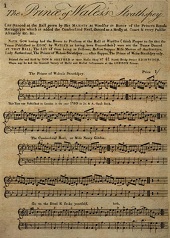 |
A note within this publication reports:
NATH. GOW having had the Honor to Perform at the Ball at Windsor (think Proper to say that the Tunes Published in EDINr by WATLEN as having been Danced their) were not the Tunes Danced AT THAT BALL. The List of them being as follows: Before Supper Miss Murray of Auchtertyre, Lady Sutherland, The Prince of Wales's Strathspey - after Supper, The Prince of Wales Strathspey only.
The contents are: The Prince of Wales's Strathspey, The Cumberland Reel, or Miss Nancy Gibson, Go to the Divel & shake yourself, A Favourite Welch Air, The Merry Wives of Windsor. The tunes are not accompanied with figures.
Full Title: The Prince of Wales's Strathspey (As Danced at the Ball given by His MAJESTY at Windsor in Honor of the Princes Royals Marriage) to which is added the Cumberland Reel, danced as a Medly at Court & every Public Assembly &c. &c.
|
Gow's Repository of the Dance Music of Scotland, Part 1
Niel Gow & Sons
1799 |

|
This is the first part of Nathaniel Gow's collection of Niel Gow's music. It's available on-line through IMSLP. It contains the music for a collection of traditional Scottish tunes, but no dancing figures are suggested for use. The image shown is of the 3rd edition.
An advert for this work printed in the Caledonian Mercury for 3rd August 1799 reads:
The arrangement of the tunes in this Book are in a new style. Besides the Public having the sets played by Niel Gow and Sons, (which is the first time their Sets have been in print, in any manner whatever,) they are arranged as Medleys, a Strathspey and Reel following alternately in their respective keys, as the frequent changing the key has been found to offend the ear. Besides the Dancing tunes, there are a good many most beautiful Slow Strathspeys, which does not interfere with the Medleys. Above eighty of the tunes, as they stand in this Repository, may be played upon the German Flute; and as the whole have been selected as being the very best tunes, the whole may be easily adapted for Military Bands.
A second edition was published in 1802.
Full Title: Part First of the Complete Repository of Original Scots slow Strathspeys and Dances. The Dances arranged as Medleys for the Harp, or Piano-forte, Violin and Violoncello &c.. Humbly Dedicated to Her Grace the Dutchess of Gordon, by Niel Gow & Son's.
|
The Mad (or Poor) Boy
Nathaniel Gow
c.1800 |
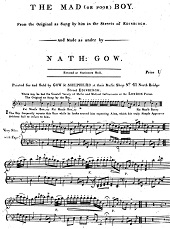
|
Two of the tunes in this collection also feature in Nathaniel's c.1800 Master F. Sitwell's Strathspey publication. It's unclear which publication was issued first.
The collection contains The Mad (or Poor) Boy, Master F. Sitwell's Strathspey and Lord Eglintounes Reel.
Full Title: The Mad (or Poor) Boy, From the Original as Sung by him in the Streets of Edinburgh, and Made as under by Nath Gow.
|
Master F. Sitwell's Strathspey
Nathaniel Gow
c.1800 |
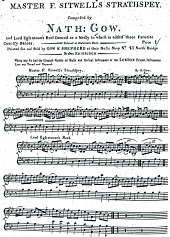
|
The collection contains Master F. Sitwell's Strathspey, Lord Eglintounes Reel, Moll in the Wadd, The Royal Quick Step and Cammolan. The tunes are not accompanied with dancing figures.
Full Title: Master F. Sitwell's Strathspey. Composed by Nath Gow. And Lord Eglintoun's Reel, Danced as a Medley to which is added three Favorite Country Dances.
Image © BRITISH LIBRARY BOARD, g.443.y.(6.) ALL RIGHTS RESERVED
|
Miss Sitwell's Strathspey
Nathaniel Gow
c.1800 |
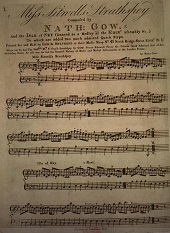
|
The collection contains Miss Sitwells Strathspey, Isle of Sky, The Marquis of Huntlys Welcome Home and Miss Mary Douglass. The tunes are not accompanied with dancing figures.
Full Title: Miss Sitwell's Strathspey. Composed by Nath Gow. And the Isle of Sky (Danced as a Medley at the Edinr Assembly &c) to which is added two much admired Quick Steps.
|
March of Col. Graham of Balgowan's Perthshire Volunteers
Nathaniel Gow
c.1800 |

|
The collection contains March of Col. Graham of Balgowan's Perthshire Volunteers, He's ay Kissing me, 1st Quick Step and Jenny's Babee, 2d Quick Step. The tunes are not accompanied with dancing figures.
Full Title: March of Col. Graham of Balgowan's Perthshire Volunteers. Composed by Nath Gow. And two Original Scotish Tunes for Quick Steps.
|
Lady Mary Ramsay's Strathspey
Nathaniel Gow
1800 |
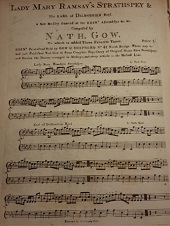
|
The collection contains Lady Mary Ramsay's Strathspey, Earl of Dalhousies Reel, The Dunkeld Volunteers, The Recovery and Ramah Droog. The tunes are not accompanied with dancing figures. It was registered for copyright purposes at Stationer's Hall on the 11th January 1800.
Full Title: Lady Mary Ramsay's Strathspey & The Earl of Dalhousies Reel, a new medley danced at the Edinr Assembly's &c.&'c. Composed by Nath Gow, to which is added Three Favorite Tunes.
|
A Fourth Collection of Strathspey Reels, etc.
Niel Gow
1800 |
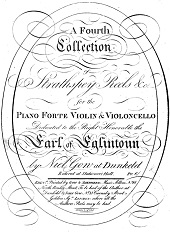 |
This work was advertised as New in the Caledonian Mercury for 21st June 1800, it wasn't registered for copyright purposes until the 3rd June 1801.
Full Title: A Fourth Collection of Strathspey Reels &c. for the Piano-Forte, Violin and Violoncello. Dedicated to the Right Honourable the Earl of Eglintoun. By Niel Gow, at Dunkeld.
|
Captain Fletcher's Favorite
Nathaniel Gow
1800 |
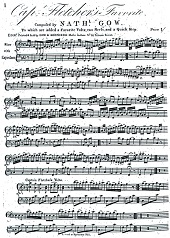
|
This publication was advertised in the Caledonian Mercury for the 2nd August 1800.
The collection contains Captain Fletcher's Favorite, Captain Fletcher's Valtz, Sir David Hunter Blair's Reel, The Divel among the Taylors and Colonel Hope's (of the 1st R.E.V.) Quick Step. The tunes are not accompanied with dancing figures.
Full Title: Capt Fletcher's Favorite. Composed by Nath Gow. To which are added a Favorite Valtz, two Reels and a Quick Step.
Image © BRITISH LIBRARY BOARD, g.229.c.(5.) ALL RIGHTS RESERVED
|
Miss Heron of Heron's Reel
Nathaniel Gow
c.1800 |

|
The collection contains Miss Heron of Heron's Reel, Mrs Garden of Troup's Strathspey, Of Noble Race was Shenkin (A Favorite Welsh Air), Jenny's Mantle and the Bugle Horn Dance. The tunes are not accompanied with dancing figures.
Full Title: Miss Heron of Heron's Reel. Composed by Nath Gow. And Mrs Garden of Troup's Strathspey a Favorite Medley Danced at the Edinr Card and Dancing Assemblys, and Two Favorite Welsh Airs, the Bugle Dance &c.
|
Lady Ann Stewart's Favorite Strathspey
Nathaniel Gow
1802 |
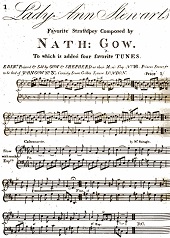
|
This collection was advertised as being Lately published in the Caledonian Mercury for the 10th June 1802.
The collection contains Lady Ann Stewart's Favorite Strathspey, Cassencarrie, The China Orange-Man, Carolane's Purse and The Dawning of Day. The tunes are not accompanied with dancing figures.
Full Title: Lady Ann Stewart's Favorite Strathspey. Composed by Nath Gow. To which is added four favorite tunes.
|
Gow's Repository of the Dance Music of Scotland, Part 2
Niel Gow & Sons
1802 |
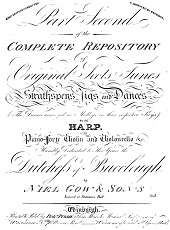
|
This is the second part of Nathaniel Gow's collection of Niel Gow's music. It's available on-line through IMSLP. It contains the music for a collection of traditional Scottish tunes, but no dancing figures are suggested for use. The image shown is of the 3rd edition.
An advert exists for this work in the Caledonian Mercury for the 27th May 1802. It went on to add:
Also, Price 6s, The SECOND EDITION of NIEL GOW's First Book of REELS, (dedicated to her Grace the Duchess of ATHOLE,) carefully Corrected and Improved, with the addition of twelve Tunes, (not to be found in the First Edition, nor in any other of his Works,) by NIEL Gow & SONS; who are sorry to observe, that notwithstanding of their causing the PLATES of the First Edition to be broke down, with a view that the Public might not be troubled with more productions from them, copies with all their errors have been taken, and lately published, both at Edinburgh and London, by persons totally unconnected with the family - none, therefore, are genuine, but such as bear the written signature of NATHANIEL GOW .
Full Title: Part Second of the Complete Repository of Original Scots Tunes, Strathspeys, Jigs and Dances. The Dances arranged as Medleys in their respective keys for the Harp, or Piano-forte, Violin and Violoncello &c.. Humbly Dedicated to Her Grace the Dutchess of Buccleugh, by Niel Gow & Son's.
|
Three Favorite New Strathspeys & one Reel
Nathaniel Gow
1802 |
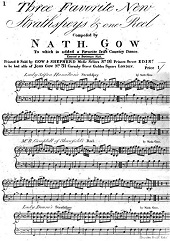 |
This work was advertised as Lately published in the Caledonian Mercury for 10th June 1802. The collection contains Lady Susan Hamilton's Strathspey, Mr R. Campbell of Shawfields Reel, Lady Doune's Strathspey, Lady E. Lindsay's Strathspey and Cary Owen.
Full Title: Three Favorite New Strathspeys & one Reel, Composed by Nath Gow, to which is added a Favorite Irish Country Dance.
|
The Earl of Moira's Welcome to Scotland
Gow & Shepherd
c.1804 |
 |
The collection contains The Earl of Moira's Welcome to Scotland, Col. Upton's merry Conceit (Nath Gow was favored with this Dance, from the Countess of Mansfield), Off she goes (Irish), Sir Philip McQue (Irish) and Hey my Nanny (Irish).
Full Title: The Earl of Moira's Welcome to Scotland, A Favourite Strathspey, to which is added Four Favourite Dances, the whole carefully corrected by Nath Gow.
|
Niel Gow's Recovery
Gow & Shepherd
1804 |
 |
This work references the year 1804 on the cover. The collection contains Niel Gow's Recovery, Lady Montgomries Reel, The Irish Wedding, The Argyle Bowling Green and Major Molle's Favorite.
Full Title: Niel Gow's Recovery, A Strathspey, and Lady Montgomrie's reel, Danced as a Medly at the Queen's Assembly in George Street the 18th. of January 1804, to which is added the Irish Wedding, a Favorite Dance and the favorite Egyptian dance &c.
|
Gow's Repository of the Dance Music of Scotland, Part 3
Niel Gow & Sons
1806 |
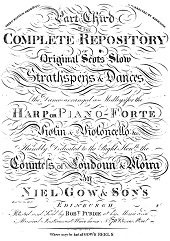
|
This is the third part of Nathaniel Gow's collection of Niel Gow's music. It's available on-line through IMSLP. It contains the music for a collection of traditional Scottish tunes, but no dancing figures are suggested for use. The image shown is of the 3rd edition.
It was advertised as Published this day in the Caledonian Mercury for the 19th April 1806.
Full Title: Part Third of the Complete Repository of Original Scots Slow Strathspeys & Dances. The Dances arranged as Medleys for the Harp, or Piano-forte, Violin & Violoncello &c.. Humbly Dedicated to the Right Honble the Countess of Loudoun & Moira, by Niel Gow & Son's.
|
The Countess of Dalhousie's Strathspey
Nathaniel Gow
c.1807 |
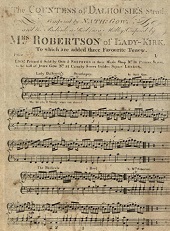 |
The collection contains Lady Dalhousie's Strathspey, The Ridicule, a Reel, Lady Charlotte Durham, The Gloucester Valtz and The Honey Moon.
Full Title: The Countess of Dalhousie's Strathspey composed by Nath Gow, and the Ridicule a Reel (as a Medley) Composed by Mrs Robertson of Lady-Kirk. To which are added three Favourite Tunes.
|
Mr Frank Walker's Strathspey
Nathaniel Gow
c.1808 |
 |
The collection contains Mr Frank Walker's Strathspey, Captain Fleming, La Perrigordien, Murphy Delaney and Lady Caroline Lee's Waltz.
Full Title: Mr Frank Walker's Strathspey composed by Nath Gow. To which is added Four Favourite Dances &c.
|
A 5th Collection of Strathspeys, Reels &c.
Niel Gow & Sons
1809 |
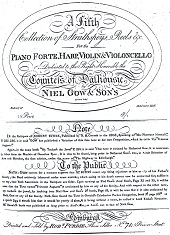
|
Nathaniel published a request for subscriptions for this work in the Caledonian Mercury for 16th Jan 1808, with an intention to publish the book itself in the ensuing Spring, or early in Summer . It was to contain all the tunes composed by Niel Gow the last seven years of his life, as those lately composed by his Sons John and Nathaniel, which have never before been in print, besides some valuable communications from Amateurs and Professional Friends, never before published . The cover includes a note that reads:
In the Reliques of Robert Burns, Published by R. H. Cromek in the 1808, Speaking of Mac Phersons Farewell, P.235.236. it is said GOW has published a Variation of this fine tune as his own Composition, which he calls The Princess Augusta . Again, in the same book My Tochers the Jewel P.291. it is said This tune is claimed by Nathaniel Gow. It is notoriously taken from the Muckin of Geordies Byre. It is also to be found, long prior to Nathaniel Gow's era, in Aird's Selection of Airs and Marches, the first edition, under the name of The Highway to Edinburgh.
To the Public: Nath Gow cannot for a moment suppose that Mr BURNS meant any thing injurious to him or any of his Father's family, the Bard evidently laboured under some mistake, which owing to his death cannot now be accounted for, suffice it to say, that both Assertions in the Reliques are false. Upon turning up Niel Gow's third Book, Page 32 and 33, it will be seen that the Tune named Princess Augusta is unclaimed by him or any of his family. And with respect to the other tune, my tocher's the jewel, by looking into Niel Gow and Son's 2d book, Page 18, it will be seen that it is also unclaimed by Nath. Gow or any of his family. Nath. Gow found the Tune in Oswald's Caledonian Pocket Companion, book 3d, page 28th as a quick Jig; it struck him that it would be pretty if slow, & it being without a name, he called it Lord Elcho's Favourite. Mr Oswald's book was published as long prior to Aird's Era, as Aird's was to that of Nath. Gow.
An advert for this work was published in the Morning Post for the 2nd June 1809.
Full Title: A fifth Collection of Strathspeys, Reels &c. for the Piano Forte, Harp, Violin & Violoncello. Dedicated to the Right Honorable the Countess of Dalhousie, by Niel Gow & Son's.
Image © BRITISH LIBRARY BOARD, h.830.d ALL RIGHTS RESERVED
|
The Favorite Dances of 1810
Nathaniel Gow |
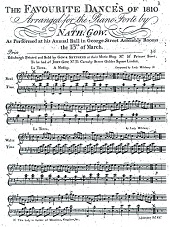
|
The collection contains La Terza, Barham Wood, Pittheavlis Castle, Tom Thumb, Noel Park, The Devil and Carrick Fergus. The tunes are not accompanied with dancing figures; some are reported to have been composed by Lady Mildmay and Miss Murray.
Full Title: The Favorite Dances of 1810, Arranged for the Piano Forte by Nath Gow. As performed at his Annual Ball in George Street Assembly Rooms, the 13th of March.
Image © BRITISH LIBRARY BOARD, g.443.y.(4.) ALL RIGHTS RESERVED
|
Lady Matilda Bruce's Reel
Nathaniel Gow
1810 |

|
The collection contains Lady Matilda Bruce's Reel, Michael Wiggans, Lady Elgins Fancy, Lady Elphinston's Favourite and Miss Gaynton's Hornpipe. The tunes are not accompanied with dancing figures.
Full Title: Lady Matilda Bruce's Reel, Composed by Nath Gow. To which is added Four favourite tunes as Performed at all Fashionable Meetings in Autumn 1810.
|
Morgiana
Printed & Sold by Gow and Shepherd
c.1810 |

|
The collection contains Morgiana, The Prime of Life, Stirling Races, The Triumph, The Runaway and Mr Stewart Ingle's Frolick. The tunes are not accompanied with dancing figures.
Full Title: Morgiana, with Five more new Country Dances.
|
Morgiana in Ireland
Nathaniel Gow
c.1810 |
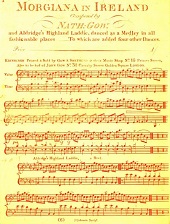
|
The collection contains Morgiana in Ireland, Aldridge's Highland Laddie, a Reel, The Hon Miss Elliot of Mintos Fancy, by Thomas Tulloh Esqr, The Bridge of Lodi, The Tarantula and The A la Grecque. The tunes are not accompanied with dancing figures.
Full Title: Morgiana in Ireland, composed by Nath Gow, and Aldridge's Highland Laddie, danced as a Medley in all fashionable places. To which are added four other Dances.
|
The Marquis of Queensberry's Medley
Nathaniel Gow
1811 |
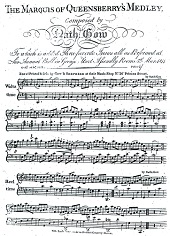
|
The collection contains Marquis of Queensberry's Medley, The Prince Regent's Medley and Orange & Blue.
Full Title: The Marquis of Queensberry's Medley, Composed by Nath Gow. To which is added Three Favorite Tunes all as performed at his Annual Ball in George Street Assembly Rooms, the 5th March 1811.
Image © BRITISH LIBRARY BOARD, g.443.y.(5.) ALL RIGHTS RESERVED
|
The Favorite Dances of 1812
Nathaniel Gow |
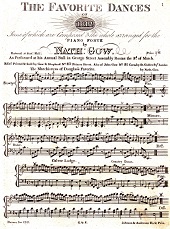
|
Gow and Shepherd advertised in the Caledonian Mercury for 30th April 1812 availability of First Set, of the much admired Collections, arranged for the Piano Forte, as danced at all the private balls in 1812 ; it was presumably in reference to this publication.
The collection contains The Marchioness of Douglas's Favorite, Calver Lodge, Sir George Clerk of Pennycuick, The Persian Dance, The Tank, Marchioness of Queensbury and Fleur's Castle. The tunes are not accompanied with dancing figures.
Full Title: The Favorite Dances of 1812, some of which are Composed & the whole arranged for the Piano Forte, by Nath Gow. As performed at his Annual Ball in George Street Assembly Rooms, the 3rd of March.
|
1st Set of Cottillions
Gow & Shepherd
1812 |
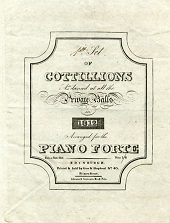
|
The date 1812 appears on the cover of this work. The collection contains La Belle Marie, La Laura et Lenza, La Nouvelle ete, La Sophie, La Dehages and La Deidamie. The tunes are not accompanied with dancing figures.
Full Title: 1st Set of Cottillions as Danced at all the Private Balls in 1812.
|
Miss Platoff's Wedding
Nathaniel Gow
1813 |

|
The collection contains Miss Platoff's Wedding, Cawdor Fair, The Caledonian Hunts March, Paddy's Frolic, Marmont's Retreat, The Legacy, La Fantasia and Carfrae Frolic. The tunes are not accompanied with dancing figures.
Full Title: Miss Platoff's Wedding, Composed by Nath Gow, To which are added the favorite Dances of 1813, as performed at his Annual Ball, George Street Assembly Rooms, the 9th of March.
|
The King Shall Enjoy His Own Again
Nathaniel Gow
c.1814 |
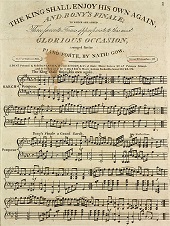
|
The collection contains The King Shall Enjoy his own again, Bony's Finale, a Grand March, The Magnanimity of Allied Crowns, The Preservers of Paris, The White Cockade and The Wee Wee Man. The tunes are not accompanied with dancing figures.
Full Title: The King Shall Enjoy His Own Again, and Bony's Finale; to which are added Three favorite Tunes appropriate to this most Glorious Occasion, arranged for the Piano Forte, by Nath Gow.
|
Lady Ann Montagu Scot, a Medley
Nathaniel Gow
1814 |
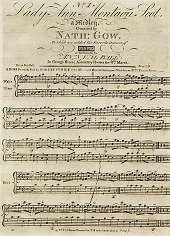
|
The collection contains Lady Ann Montagu Scot's Waltz, Lady Ann Montagu Scot's Reel, Hogmany Strathspey, The Scotish Legacy, Lady Mary Bertie, Tannadice House, The Muses, Calabrea and Rokeby. The tunes are not accompanied with dancing figures.
Full Title: 1. Lady Ann Montagu Scot, a Medley. Composed by Nath Gow. To which are added the Favorite Dances of 1814, as performed at his Annual Ball in George Street Assembly Rooms, the 8th of March.
|
The Earl of Dalhouseie's Welcome From The Pyrenees
Nathaniel Gow
1814 |
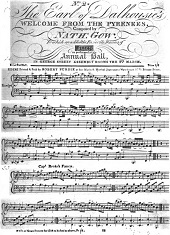
|
The collection contains The Earl of Dalhouseie's Welcome From The Pyrenees, Capt Broke's Fancy, Enrico, The Copenhagen Waltz, Miss Alicia Baird's Reel, Miss Samunda's Fancy and Paddy O'Snap. The tunes are not accompanied with dancing figures.
Full Title: 2. The Earl of Dalhouseie's Welcome From The Pyrenees. Composed by Nath Gow. To which are added the Favorite Dances of 1814, as performed at his Annual Ball in George Street Assembly Rooms, the 8th of March.
|
A Select Collection of Original Dances
Nathaniel Gow
1815 |

|
An advert in the Caledonian Mercury for 12th December 1814 reads:
NATHANIEL GOW begs leave most respectfully to acquaint the Ladies and Gentlemen who have bespoke his NEW BOOK (dedicated to the Marchioness of Queensberry), that it will be ready for delivery in a few weeks, of which due notice will be given. The book contains the favourite FANCY TUNES, AIRS, WALTZES, &c. as performed for many years by N.G. and Band, none of which are to be found in the works hitherto published by him, under the name of Niel Gow and Sons. N.G. hopes the style of this book will be a pleasing deviation from his former ones.
Full Title: A Select Collection of Original Dances, Waltzes, Marches Minuets, & Airs. Respectfully Dedicated to the Most Noble Marchioness of Queensberry. Many of which are Composed, and the whole Arranged for the Piano Forte and Harp by Nath. Gow.
|
Marchioness of Huntly's Strathspey
Nathaniel Gow
1815 |
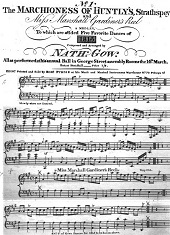
|
The collection contains Marchioness of Huntly's Strathspey, Miss Marshall Gardiner's Reel, Biddlestone Punch Strathspey, Halloween, A Trip to Dublin, The Favorite Sicilian Dance, and Miss Mitchelson of Middleton's Waltz. The tunes are not accompanied with dancing figures.
Full Title: 1. The Marchioness of Huntly's Strathspey and Miss Marshall Gariner's Reel, a Medley. To which are added Five Favorite Dances of 1815, Composed and Arranged by Nath Gow; All as performed at his annual Ball in George Street assembly Rooms the 14th of March.
|
Lady Hunter Blair's Reel and Waltz
Nathaniel Gow
1815 |
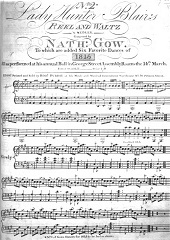
|
The collection contains Lady Hunter Blair's Reel, Lady Hunter Blair's Waltz, The Batteuse, Miss Gregson's Strathspey, The Devil in Denmark, Lady Johnston's Reel, The Gallant Hope of the Endymion and America. The tunes are not accompanied with dancing figures.
Full Title: 2. Lady Hunter Blair's Reel and Waltz, a Medley. Composed by Nath Gow. To which are added Six Favorite Dances of 1815. All as performed at his annual Ball in George Street Assembly Rooms the 14th of March.
|
The Marquis of Tweeddale's Favorite
Nathaniel Gow
1816 |
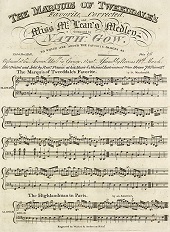
|
This collection is dated to 1816 based on the date of the Ball referenced on the cover.
The collection contains The Marquis of Tweeddale's Favorite, The Highlandman in Paris, The Beauty, Miss McLean's Medley, Lady Don's Waltz and Alexander. The tunes are not accompanied with dancing figures.
Full Title: The Marquis of Tweeddale's Favorite, Corrected; and Miss McLean's Medley. Composed by Nath Gow. To which are added the favorite dances as performed at his Annual Ball in George Street Assembly Rooms 12th March.
|
Waterloo Medley
Nathaniel Gow
1816 |

|
This collection is dated to 1816 based on the date of the Ball referenced on the cover.
The collection contains The Waterloo Strathspey, The Waterloo Reel, Musing on board the Bellerophon, Boney's awa, If he bide awa, we'll say good bye to Boney, The Roxburgh Ball, a Medley, The Roxburgh Ball Reel, The Batteuse.
Full Title: Waterloo Medley, composed by Nath Gow. To which are added the Favorite Tunes, Composed by Him, for the Queens Assembly held in George Street Rooms, Friday the 19th January, 1816.
|
Gow's Repository of the Dance Music of Scotland, Part 4
Niel Gow & Sons
1817 |
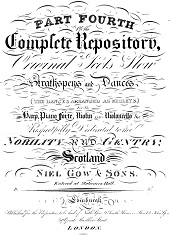
|
This is the fourth part of Nathaniel Gow's collection of Niel Gow's music, advertised as new in the Caledonian Mercury for the 27th September 1817. It's available on-line through IMSLP.
Full Title: Part Fourth of the Complete Repository of Original Scots Slow Strathspeys & Dances. The Dances arranged as Medleys for the Harp, Piano-forte, Violin and Violoncello &c.. Respectfully Dedicated to the Nobility and Gentry of Scotland, by Niel Gow & Son's.
|
Nathaniel Gow's 1st Set
of Quadrilles
1817 |
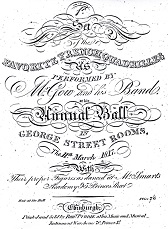
|
This set of Quadrilles were published and sold by Robert Purdie at his Music and Musical Instrument Warehouse, 70 Princes Street . They're a duplicate of Edward Payne's c.1815 First Set (both the music and dancing notation are identical), except that Payne's La Trénise Quadrille is replaced with a Quadrille called La Gertrude, the figures for which are identical to Payne's dance, the music differs. Payne wasn't credited. The cover confirms that they were danced in Edinburgh in March 1817. The figures are given in both French and English.
Full Title: 1st Set of the Favorite French Quadrilles as performed by Mr. Gow and his Band, at his Annual Ball. In George Street Rooms, The 11th March 1817. With their proper figures as danced at Mr Smart's Academy, 95 Princes Street. Price 2/6.
Image © BRITISH LIBRARY BOARD, g.230.bb.(1.) ALL RIGHTS RESERVED
|
Nathaniel Gow's 2nd Set
of Quadrilles
1817 |
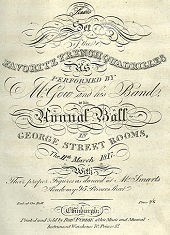
|
As with Nathaniel Gow's First Set, these were danced at a Ball in Edinburgh on the 11th March 1817. The contents are: La Paysanne (Pastorale), Le Petite Bonne (La Poule), Duc De Berry, La Nouvelle Julie, La Mornette and La Caprice. The figures are given in both French and English.
The music for the first dance, La Paysanne, is from James Paine's c.1816 First Set. The final dance, La Caprice, is a little usual for containing a figure called Le rond a la D'Egville. D'Egville was a ballet master in London, and one of the most prestigious dancers of the Regency era, Nathaniel Gow mentioned him in several works, hinting that they may have been friends. I have no information on how the D'Egville Rond differed from a regular Rond. The music for La Caprice changes time signature part way through; this is very unusual in a Quadrille, though it is seen amongst the Cotillions of the 1770s.
Full Title: 2nd Set of the Favorite French Quadrilles as performed by Mr. Gow and his Band, at his Annual Ball. In George Street Rooms, The 11th March 1817. With their proper figures as danced at Mr Smart's Academy, 95 Princes Street. Price 2/6.
Image Courtesy of Wikimedia Commons.
|
Nathaniel Gow's 3rd Set
of Quadrilles
1817 |
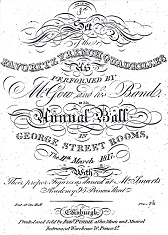
|
As with Nathaniel Gow's First Set, these were danced at the Ball in Edinburgh on the 11th March 1817. The contents are: La Belle Alliance, La Gossellina, La Minaudiere, Les Plaisers D'Annay, La Favorite and Le Coburg. The figures are given in both French and English. This Set contains precise timing information, and are therefore much easier to interpret than the Second Set.
Full Title: 3rd Set of the Favorite French Quadrilles as performed by Mr. Gow and his Band, at his Annual Ball. In George Street Rooms, The 11th March 1817. With their proper figures as danced at Mr Smart's Academy, 95 Princes Street. Price 2/6.
Image © BRITISH LIBRARY BOARD, g.230.bb.(1.) ALL RIGHTS RESERVED
|
John H. Gow's 1st Set
of Quadrilles
1817 |
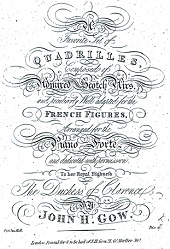
|
The existence of this Quadrille Set are advertised in The Morning Post, 1st July 1817. It indicates that they were collected in Paris . A subsequent advert in The British Press, 9th July 1823, indicates that they'd been republished arranged as duets for the Pianoforte, by D. Bruguier . John H. Gow was the son of John Gow, and nephew of Nathaniel, a partner in the John Gow & Son business.
The Quadrilles are My Love She's But a Lassie Yet, There's Nae Luck About The House, Kenmure's Awa, The Highland Laddie and Callam Shiarghlas.
Full Title: A Favorite Set of Quadrilles, Composed of Admired Scotch Airs and particularly well adapted for the French Figures, Arranged for the Piano Forte and dedicated with permission To Her Royal Highness The Duchess of Clarence, by John H. Gow.
Image © BRITISH LIBRARY BOARD, h.830.(19.) ALL RIGHTS RESERVED
|
#1 New Selection of Quadrilles, Waltzes & Spanish Country Dances
Nathaniel Gow
c.1817 |
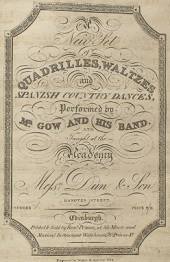
|
This collection is made up of L'Inconstante, La Polonaise, La Ronde and Contradanza Espanola (an unusually early occurrence of a Spanish Country Dance published in Scotland).
Full Title: A New Selection of Quadrilles, Waltzes and Spanish Country Dances, performed by Mr Gow and his Band, and taught at the academy of Messrs Dun & Son. Price 2/6.
Image © BRITISH LIBRARY BOARD, g.442.f.(13.) ALL RIGHTS RESERVED
|
#2 New Selection of Quadrilles, Waltzes & Spanish Country Dances
Nathaniel Gow
c.1817 |
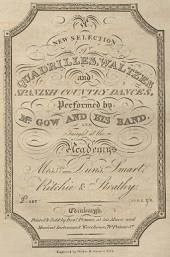
|
This collection of Quadrilles is made up of La Portugaise, La Bonne Amie, La Paris, La Wellington, La Pastorale, and La Ronde. This Set became known as The Second Set in various Scottish publications, including Barclay Dun's 1818 A Translation of Nine of the Most Fashionable Quadrilles, and the Lowes' Ball-Conductor and Assembly Guide.
Full Title: A New Selection of Quadrilles, Waltzes and Spanish Country Dances, performed by Mr Gow and his Band, and taught at the academys of Messrs Duns, Smart, Ritchie & Strathy. 2nd Set. Price 2/6.
Image © BRITISH LIBRARY BOARD, g.442.f.(13.) ALL RIGHTS RESERVED
|
#3 New Selection of Quadrilles, Waltzes & Spanish Country Dances
Nathaniel Gow
c.1817 |

|
This collection of Quadrilles is made up of La Floride, La Valse en Cotillon, Les Graces, and D'Egville. This Set became known as The Third Set in various Scottish publications, including Barclay Dun's 1818 A Translation of Nine of the Most Fashionable Quadrilles, and the Lowes' Ball-Conductor and Assembly Guide.
The Waltz Cotillion is an early example of a Quadrille in Waltz time, though the dancing master Edward Payne published a similar set of waltz tunes adapted for Quadrille dancing c.1816.
Full Title: A New Selection of Quadrilles, Waltzes and Spanish Country Dances, performed by Mr Gow and his Band, and taught at the academys of Messrs Duns, Smart and Ritchie. 3rd Set. Price 2/6.
Image © BRITISH LIBRARY BOARD, g.442.f.(13.) ALL RIGHTS RESERVED
|
#4 New Selection of Quadrilles, Waltzes & Spanish Country Dances
Nathaniel Gow
c.1818 |
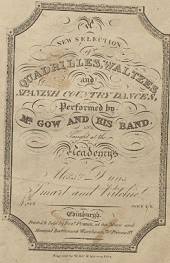
|
This collection of Quadrilles is made up of La Nouvelle Paris, Le Carré, La Polonaise, La Vivacité, and La Poulette Finale. The figures for this Set are also available in Barclay Dun's 1818 A Translation of Nine of the Most Fashionable Quadrilles.
Full Title: A New Selection of Quadrilles, Waltzes and Spanish Country Dances, performed by Mr Gow and his Band, and taught at the academys of Messrs Duns, Smart and Ritchie. 4th Set. Price 2/6.
Image © BRITISH LIBRARY BOARD, g.442.f.(13.) ALL RIGHTS RESERVED
|
The Beauties of Niel Gow, part 1
Niel Gow & Sons
1818 |
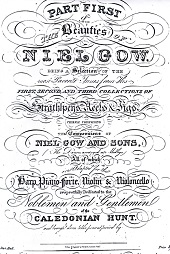
|
A brief reference to this work appears in the inventory of a circulating library, advertised in the Perthshire Courier, 24th December 1818.
Full Title: Part First of The Beauties of Niel Gow. Being a selection of the most favorite tunes from his First, Second and Third Collections of Strathspeys, Reels & Jigs. Chiefly comprising the compositions of Niel Gow and Sons. The Dances arranged as Medleys, all of which are adapted for the Harp, Piano Forte, Violin & Violoncello, respectfully dedicated to the Noblemen and Gentlemen of the Caledonian Hunt.
Image © BRITISH LIBRARY BOARD, h.830.(7.) ALL RIGHTS RESERVED
|
The Favorite New Tunes as Danced to the First Set of Quadrilles in 1819
Nathaniel Gow |

|
This collection of Quadrilles is made up of two sets. The first was selected in Paris by the Editor's Nephew J.H. Gow, London , it consists of Miss Moray of Abercarney's Favorite, Miss Inglis' Favorite, Miss Fanny McAlister's Favorite, Miss Boog's Favorite and Finale. The second set was composed and selected by Mr A. Murray, Edinburgh , it consists of Miss Maxwell of Monreith's Favorite, Miss Alexander of Balochmyle's Favorite, Miss Campbell of Succoth's Favorite, Miss Catherine Jardine's Favorite and Finale.
Full Title: The Favorite New Tunes as Danced to the First Set of Quadrilles in 1819. Being the favorite ones performed by N. Gow and his band at George Street Assembly Rooms and all Fashionable Parties. The whole carefully arranged by Nath Gow.
|
#7 New Selection of Quadrilles, Waltzes & Spanish Country Dances
Nathaniel Gow
c.1819 |
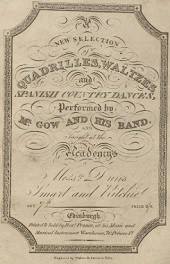
|
This collection of Quadrilles is made up of Monaco, Gavottine, Le Bon Frére, Le Desir and La Belle Caroline.
This collection is unlikely to date later than 1819, when Nathaniel Gow opened a new music shop with his son Niel. Publications from that date were issued through his own music store.
Full Title: A New Selection of Quadrilles, Waltzes and Spanish Country Dances, performed by Mr Gow and his Band, and taught at the academys of Messrs Duns, Smart and Ritchie. 7th Set. Price 2/6.
Image © BRITISH LIBRARY BOARD, g.442.f.(13.) ALL RIGHTS RESERVED
|
#8 New Selection of Quadrilles, Waltzes & Spanish Country Dances
Nathaniel Gow
c.1819 |
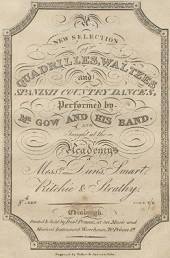
|
This collection of Quadrilles is made up of La Blondine, Les Plumes, L'Espagnole, La Colombe, and Les Bains Chinoises.
Full Title: A New Selection of Quadrilles, Waltzes and Spanish Country Dances, performed by Mr Gow and his Band, and taught at the academys of Messrs Duns, Smart, Ritchie & Strathy. 8th Set. Price 2/6.
Image © BRITISH LIBRARY BOARD, g.442.f.(13.) ALL RIGHTS RESERVED
|
The Beauties of Niel Gow, part 2
Niel Gow & Sons
1819 |

|
The existence of this work is mentioned in an advert in the Caledonian Mercury for the 27th February 1819.
Full Title: 2nd Part of The Beauties of Niel Gow. Being a selection of the most favorite tunes from his First, Second and Third Collections of Strathspeys, Reels & Jigs. Chiefly comprising the compositions of Niel Gow and Sons. The Dances arranged as Medleys, all of which are adapted for the Harp, Piano Forte, Violin & Violoncello, respectfully dedicated to the Noblemen and Gentlemen of the Caledonian Hunt.
Image © BRITISH LIBRARY BOARD, h.830.(7.) ALL RIGHTS RESERVED
|
The Prince Regent's Favorite
John & Nathaniel Gow
1819 |
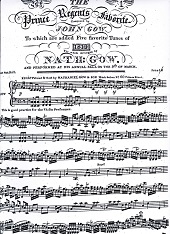
|
The collection also contains The Duke of Buccleugh's Favorite, Lament for Sir John Stewart Bar, Miss Hamilton of Wishaw's Medley and Miss Mary Swinton's Delight.
Full Title: The Prince Regent's Favorite, composed by John Gow, to which are added five favorite tunes of 1819. The whole arranged by Nath: Gow. and performed at his annual ball on the 9th of March.
Image © BRITISH LIBRARY BOARD, h.830.(9.) ALL RIGHTS RESERVED
|
Lament for Mr Sharpe of Hoddom
Nathaniel Gow & Son
1819 |
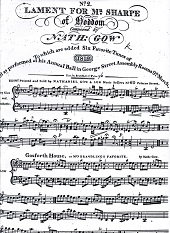
|
The collection also contains Gosforth House, Dunse Castle, Waltz, Airly Castle and Meg Merrillies.
Full Title: No 2. Lament for Mr. Sharpe of Hoddom. Composed by Nath: Gow. To which are added Six Favorite Tunes of 1819. All as performed at his Annual Ball in George Street Assembly Rooms, 9th March.
Image © BRITISH LIBRARY BOARD, h.830.(10.) ALL RIGHTS RESERVED
|
The Cries of Edinburgh
Nathaniel Gow & Son
1820 |
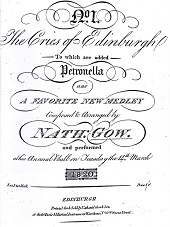
|
The collection also contains Hot Vyes, Kail & Leaks, Petronella and Gosforth Masquerade.
Full Title: No 1. The Cries of Edinburgh, to which are added Petronella and A Favorite New Medley, composed & arranged by Nath: Gow. and performed at his Annual Ball on Tuesday the 14th March 1820.
Image © BRITISH LIBRARY BOARD, h.830.(11.) ALL RIGHTS RESERVED
|
The Celtic Club
Nathaniel Gow & Son
1820 |
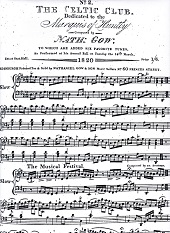
|
The collection also contains The Musical Festival, Blow thou Northern Wind, John of Paris, Miss Brown's Waltz, Peterkoff and Count Platoff.
Full Title: No 2. The Celtic Club. Dedicated to the Marquis of Huntly, composed by Nath: Gow: to which are added six favorite tunes, as performed at his Annual Ball on Tuesday the 14th March, 1820.
Image © BRITISH LIBRARY BOARD, h.830.(12.) ALL RIGHTS RESERVED
|
The Highland (or Celtic) Ball
Nathaniel Gow & Son
1821 |
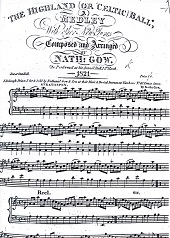
|
The collection also contains Mr Robert Ramsay's Favorite, Miss Irvine's Reel, The Hare Craigs, Draps o'Whisky and Mr Kinloch of Kinloch's Favorite.
Full Title: The Highland (or Celtic) Ball, A Medley with other new tunes Composed and Arranged by Nath: Gow. As Performed at his Annual Ball, 13th March 1821.
Image © BRITISH LIBRARY BOARD, h.830.(13.) ALL RIGHTS RESERVED
|
Lady Moncrieff of Moncrieff's Medley
Nathaniel Gow
1821 |
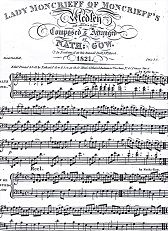
|
The brief collection contains Lady Moncrieff's Waltz and Lady Moncrieff's Reel (which together form the Medley), the Lament for Mr. Ramsay of Barton and The New Lancers by Nathaniel Gow. It's particularly interesting as being the first collection of Gow Country Dances (that I'm aware of) since 1788 to include dancing figures as well as tunes. Nathaniel's earlier publications tended to only include music, presumably as any figures could be danced to the tunes.
Full Title: Lady Moncrieff of Moncrieff's Medley with other new tunes, composed & arranged by Nathaniel Gow. As performed at his Annual Ball, 13th March 1821. Price 1s6d.
Image © BRITISH LIBRARY BOARD, h.830.(14.) ALL RIGHTS RESERVED
|
John H. Gow's 2nd Set
of Quadrilles
1821 |
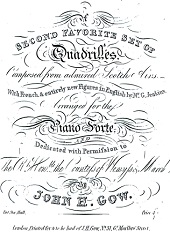
|
The publication of this Set was advertised in The Morning Chronicle, 30th January 1821.
John H. Gow credited the figures for this Quadrille Set to Mr. G. Jenkins.
The Quadrilles are arranged to be compatible with the First Set. They are: Willie Was A Wanton Wag (Pantalon), On A Bank of Flowers (L'Ete), The Deuks Dang O'er My Daddie (La Poule), The White Cockade (Pastourelle) and Johnie Cope.
Full Title: A Second Favorite Set of Quadrilles. Composed from admired Scotch Airs. With French & entirely new Figures in English by Mr. G. Jenkins. Arranged for the Piano Forte and dedicated with permission to The Right Honorable the Countess of Wemyss & March. By John H. Gow. Price 4s.
Image © BRITISH LIBRARY BOARD, h.830.(19.) ALL RIGHTS RESERVED
|
John H. Gow's 3rd Set
of Quadrilles
1822 |
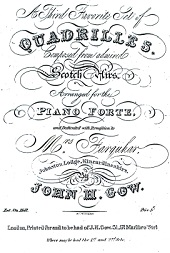
|
This set were advertised as just published in the Morning Post for 20th February 1822.
The contents are Corn Riggs, The Bonny Highland Laddie, Johnny McGill, Aiken Drum and O'er the Water to Charlie.
Full Title: A Third Favorite Set of Quadrilles. Composed from admired Scotch Airs. Arranged for the Piano Forte, and dedicated with permission to Mrs Farquhar, Johnston Lodge, Kincardineshire. By John H. Gow.
Image © BRITISH LIBRARY BOARD, h.830.(19.) ALL RIGHTS RESERVED
|
John H. Gow's 4th Set
of Quadrilles
1822 |
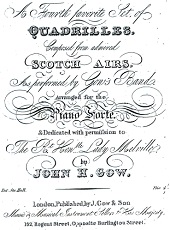
|
The contents are Weel May the Boatie Row, Cauld Kail in Aberdeen, The Campbell's are Coming, There's Nae Luck About The House and Ayr Races.
Full Title: A Fourth favorite Set of Quadrilles. Composed from admired Scotch Airs. As performed by Gow's Band. Arranged for the Piano Forte, and dedicated with permission to The Rt Honble Lady Melville. By John H. Gow.
Image © BRITISH LIBRARY BOARD, h.830.(19.) ALL RIGHTS RESERVED
|
John H. Gow's 5th Set
of Quadrilles
1822 |
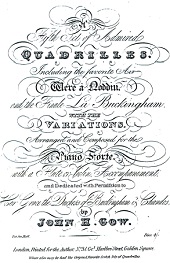
|
An advert in The Morning Post, 30th May 1822, indicates the existence of this Quadrille Set. It was reported to include the favourite Airs, "We're a' Noddin'", and the Finale; "La Buckingham," with the Variations, dedicated with permission to the Duchess of Buckingham and Chandos .
The contents are La Duchesse, We're A Noddin at our House at Hame, L'Augustine, L'Orpheus and La Buckingham.
Full Title: A Fifth Set of Admired Quadrilles. Including the favorite Air "We're A Noddin" and the finale "La Buckingham", with the variations. Arranged and Composed for the Piano Forte, with a Flute or Violin Accompaniment, and dedicated with permission to Her Grace the Duchess of Buckingham & Chandos. By John H. Gow.
Image © BRITISH LIBRARY BOARD, h.830.(19.) ALL RIGHTS RESERVED
|
A 6th Collection of Strathspeys, Reels &c.
Niel Gow & Sons
1822 |
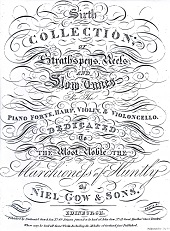
|
This is a late collection of Scottish folk tunes published by Nathaniel under his father's name.
Full Title: Sixth Collection of Strathspeys, Reels and Slow Tunes for the Piano Forte, Harp, Violin & Violoncello. Dedicated to the Mpst Noble the Marchioness of Huntly, by Niel Gow & Son's.
Image © BRITISH LIBRARY BOARD, h.830.(6.) ALL RIGHTS RESERVED
|
A Favorite Set of Quadrilles for 1822
Nathaniel Gow |
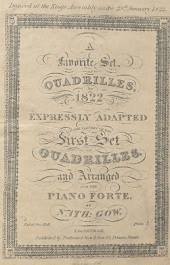
|
This collection is made up of alternative tunes for use with the First Set of Quadrille figures: Le Pantalon, L'Ete, La Poule, La Trenise, and La Finale. A note on the cover indicates that they were Danced at the King's Assembly on the 29th January 1822 .
Full Title: A Favorite Set of Quadrilles for 1822, expressly adapted for the figures of the First Set of Quadrilles, and arranged for the Piano Forte, by Nath Gow. Price 3s.
Image © BRITISH LIBRARY BOARD, h.830.(12.) ALL RIGHTS RESERVED
|
Five Favorite Country Dances for 1822
Nathaniel Gow |
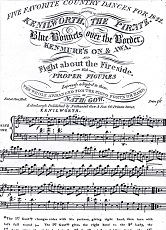
|
This collection is made up of Kenilworth, The Pirate, Blue Bonnets Over The Border, Kenmure's On & Awa, and Fight About The Fire Side. They contain both the music and dancing figures for the 5 dances.
Full Title: Five Favorite Country Dances for 1822. Consisting of Kenilworth. The Pirate. Blue Bonnets Over The Border. Kenmure's On & Awa. And Fight about the Fireside. With proper figures expressly adapted for the Piano Forte or Harp by Nath: Gow. Price 1s6d.
Image © BRITISH LIBRARY BOARD, h.724.r.(15.) ALL RIGHTS RESERVED
|
Gow's Favorite Dances for 1823
John Gow & Son |
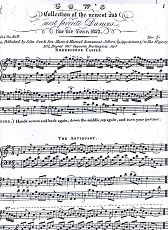
|
This collection of Country Dances is made up of Sherbourne Castle, The Antiquary, Rosabella, Mandane, Lady Melville's Strathspey, Saint Andrew's Day, and Lucretia. They include the figures for each dance, with the exception of Lady Melville's Strathspey.
Full Title: Gow's Collection of the newest and most favorite Dances For the Year 1823. Price 1s. London, Published by John Gow & Son, Music & Musical Instrument Sellers (by Appointment) to His Majesty.
Image © BRITISH LIBRARY BOARD, h.830.(16.) ALL RIGHTS RESERVED
|
The Ancient Curious Collection of Scotland
Nathaniel Gow
1823 |
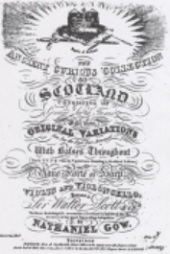
|
This collection was advertised in The Scots Magazine for 1st February 1823.
Full Title: The Ancient Curious Collection of Scotland, consisting of genuine Scotch Tunes, with their original Variations, now, for the first time, arranged with Basses throughout, with the view of preserving those ingenious productions from oblivion; by Nathaniel Gow; each Tune, with its variations, forming a distinct Lesson for the Piano-forte or Harp, Violin, and Violoncello. Dedicated to Sir Walter Scott, Bart. 8s..
|
Donna del Lago Quadrilles
John H. Gow
c.1823 |
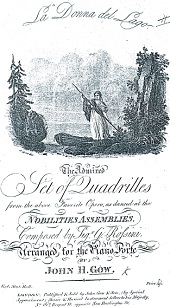
|
Full Title: La Donna del Lago, the Admired Set of Quadrilles from the above Favorite Opera, as danced at the Nobilities Assemblies. Composed by Sig. G. Rossini. Arranged for the Piano Forte, by John H. Gow.
Image © BRITISH LIBRARY BOARD, h.830.(18.) ALL RIGHTS RESERVED
|
Afterword
Buffy Benson, a correspondent researching family history, has written from Australia to comment on the significant impact that Nathaniel Gow's daughters had there. Nathaniel's daughter Augusta (progeny of his second marriage) married R. C. Packer the founder of the Packer media dynasty; his daughter Margaret (progeny of his first marriage) married the settler Adam Armstrong after whom the Perth suburb of Dalkeith is named.
We'll leave this investigation here. If you have more information to share do please Contact Us as we'd love to know more. If you're lucky enough to own historical collections of dance music or notation, please do consider sharing them with the community of amateur enthusiasts who recreate such dances. I'm very grateful to the British Library and others for allowing me to investigate their archives, I look forward to a time when we can all view and study these same treasures at ease.
|


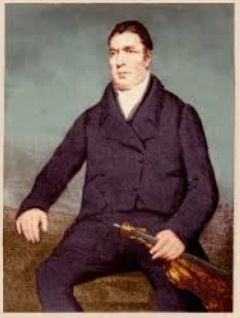 Figure 1. Nathaniel Gow. Image coloured by Alan Watson of The Scottish Fiddle Society. The original image was collected from the 1895 Glen Collection of Scottish Dance Music.
Figure 1. Nathaniel Gow. Image coloured by Alan Watson of The Scottish Fiddle Society. The original image was collected from the 1895 Glen Collection of Scottish Dance Music.
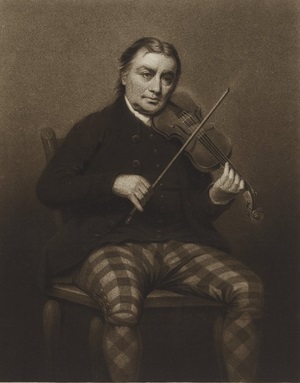 Figure 2. Niel Gow
Figure 2. Niel Gow  Figure 3. A Celebrated Performer in the Philharmonic Society, 1818
Figure 3. A Celebrated Performer in the Philharmonic Society, 1818  Figure 4. The Morning Post, 27th March 1804.
Figure 4. The Morning Post, 27th March 1804.  Figure 5. The Morning Post, 8th October 1808.
Figure 5. The Morning Post, 8th October 1808.  Figure 6. New Scotch Music by George Jenkins, 1797
Figure 6. New Scotch Music by George Jenkins, 1797  Figure 7. Imagery from Victorian editions of Gow's Quadrilles
Figure 7. Imagery from Victorian editions of Gow's Quadrilles  Figure 8. The Gow band plays at Vauxhall Gardens, The Morning Post, 7th July 1825. Image © THE BRITISH LIBRARY BOARD. ALL RIGHTS RESERVED. Image reproduced with kind permission of The British Newspaper Archive (www.britishnewspaperarchive.co.uk)
Figure 8. The Gow band plays at Vauxhall Gardens, The Morning Post, 7th July 1825. Image © THE BRITISH LIBRARY BOARD. ALL RIGHTS RESERVED. Image reproduced with kind permission of The British Newspaper Archive (www.britishnewspaperarchive.co.uk)
 Figure 9. The Caledonian Mercury, 22nd March 1821. Image © THE BRITISH LIBRARY BOARD. ALL RIGHTS RESERVED. Image reproduced with kind permission of The British Newspaper Archive (www.britishnewspaperarchive.co.uk)
Figure 9. The Caledonian Mercury, 22nd March 1821. Image © THE BRITISH LIBRARY BOARD. ALL RIGHTS RESERVED. Image reproduced with kind permission of The British Newspaper Archive (www.britishnewspaperarchive.co.uk)